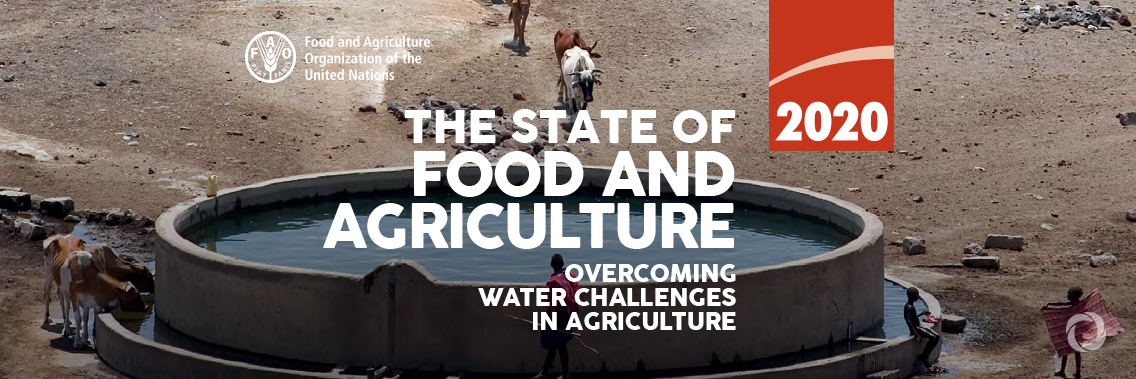More than three billion people live in agricultural areas with high to very high levels of water shortages and scarcity, and almost half of them face severe constraints. Furthermore, available freshwater resources per person have declined by more than 20 percent over the past two decades globally, underscoring the importance of producing more with less, especially in the agriculture sector, the world’s largest user of water.
Improved water management, supported by effective governance and strong institutions – including secure water tenure and rights, underpinned by sound water accounting and auditing – will be essential to ensure global food security and nutrition, and contribute to the Sustainable Development Goals (SDGs), according to The State of Food and Agriculture (SOFA) 2020 – a flagship report published by the Food and Agriculture Organization of the United Nations.
“With this report, FAO is sending a strong message: water shortages and scarcity in agriculture must be addressed immediately and boldly if our pledge to achieve the SDGs is to be taken seriously,” FAO Director-General QU Dongyu emphasized in the foreword of the report.
Paths for action range from investing in water-harvesting and conservation in rainfed areas to rehabilitating and modernizing sustainable irrigation systems in irrigated areas. These must be combined with best agronomic practices, such as adopting drought-tolerant crop varieties, and improved water management tools – including effective water pricing and allocation tools, such as water rights and quotas – to ensure equitable and sustainable access. Water accounting and auditing must be, however, the starting point for any effective management strategy.
Achieving the internationally agreed SDG pledges, including the Zero Hunger target (SDG 2), “is still achievable,” the SOFA emphasizes – but only by ensuring more productive and sustainable use of freshwater and rainwater in agriculture, which accounts for more than 70 percent of global water withdrawals.
FAO’s SOFA report in 1993 also focused on water issues, and today it is striking how the findings presented then remain valid and relevant today. While the previous report focused on irrigation, the new edition broadens its scope to cover water-related challenges in rainfed agriculture, which represents more than 80 percent of land under cultivation and 60 percent of global crop production.
Mapping the moisture
About 1.2 billion people – 44 percent of them in rural areas and the remainder in small urban centers in the countryside – live in places where severe water shortages and scarcity challenge agriculture. Around 40 percent of them live in Eastern and South-eastern Asia, and a slightly higher share in Southern Asia. Central Asia and Northern Africa and Western Asia are also severely affected – about one of every five people live in agricultural areas with very high water shortages and scarcity, compared to less than 4 percent in Europe, Latin America and the Caribbean, Northern America and Oceania.
About 5 percent of people living in sub-Saharan Africa live in similar conditions, meaning that about 50 million people live in areas where severe drought has catastrophic impacts on cropland and pastureland once every three years.
About 11 percent of the world’s rainfed cropland, or 128 million hectares, face frequent drought, as does about 14 percent of pastureland, or 656 million hectares. Meanwhile, more than 60 percent (or 171 million hectares) of irrigated cropland is highly water-stressed. 11 countries, all in Northern Africa and Asia, face both challenges, making it urgent and necessary to adopt sound water accounting, clear allocation, modern technologies and to shift to less thirsty crops.
Did you know?
- The average amount of freshwater per person in 2017 was about 43 000 m3 in Oceania, while barely reaching 1 000 m3 in Northern Africa and Western Asia.
- Total water withdrawals per capita are highest in Central Asia, reaching almost 2 000 m3 per person in 2017, compared to less than 130 m3 in sub-Saharan Africa.
- In the least developed countries, 74 percent of rural people do not have access to safe drinking water.
- 91 countries have national plans for rural drinking water, but only nine have allocated sufficient funding to implement them.
- Around 41 percent of current global irrigation occurs at the expense of environmental flow requirements, which are essential to sustain ecosystems that provide life-supporting functions.
- Biofuels require 70 to 400 times more water than do the fossil fuels they replace.
- Major forests in areas such as the Amazon, Congo, and Yangtze river basins are important sources of water vapour for areas downwind and are, therefore, crucial to rainfed agriculture.
Read the report: The State of Food and Agriculture (SOFA) 2020.
Original source: FAO

